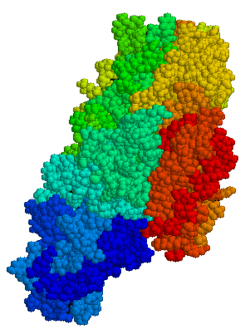Gliadin
Gliadin is a class of proteins present in wheat and several other cereals within the grass genus Triticum. Gliadins, which are a component of gluten, are essential for giving bread the ability to rise properly during baking. Gliadins and glutenins are the two main components of the gluten fraction of the wheat seed. This gluten is found in products such as wheat. Gluten is split about evenly between the gliadins and glutenins, although there are variations found in different sources.
Gliadin is the soluble aspect of gluten, while glutenin is insoluble. There are three main types of gliadin (α, γ, and ω), to which the body is intolerant in coeliac (or celiac) disease. Diagnosis of this disease has recently been increasing. Gliadin has primarily monomeric proteins, which differs from glutenin, which has primarily polymers.[1]
Types
The α, γ, and ω gliadin types are separated and distinguished based on their amino acid sequences.[2]
- α-/β-gliadins – soluble in low-percentage alcohols.
- γ-gliadins – ancestral form of cysteine-rich gliadin with only intrachain disulfide bridges
- ω-gliadins – soluble in higher percentages, 30–50% acidic acetonitrile.
Biochemistry
Gliadins are prolamins and are separated on the basis of electrophoretic mobility and isoelectric focusing.
Metabolism
Gliadins are known for their role, along with glutenin, in the formation of gluten. They are slightly soluble in ethanol and contain only intramolecular disulfide links. They also cause some of the best examples of food-derived pathogenesis. People with gluten-sensitive enteropathy (the severe form of which is celiac disease) are sensitive to α, β, and γ gliadins. Those with WD urticaria and Baker's asthma are sensitive to ω-gliadins.

Gliadin can also serve as a useful delivery method for sensitive enzymes (such as superoxide dismutase, which is fused with gliadin to form glisodin) -- this helps protect them from stomach acids that cause breakdown.
For useful description of the gliadins see:
Deamidated gliadin
Deamidated gliadin is produced by acid or enzymatic treatment of gluten. The enzyme tissue transglutaminase converts some of the abundant glutamines to glutamic acid. This is done because gliadins are soluble in alcohol and cannot be mixed with other foods (like milk) without changing the foods' qualities. Deamidated gliadin is soluble in water. The cellular immunity to deamidated α-/β-gliadin is much greater than α/β-gliadin and can result in symptomatic gluten-sensitive enteropathy.
Glisodin
Superoxide dismutase (SOD) is naturally created by the body to help protect against damage to the cells. Glisodin wraps gliadin around SOD - the gliadin protects the SOD from the acids inside of the stomach and allows it passage to the intestines to be absorbed by the body. This new ingredient has been under tests to both animals and humans for benefits. Most tests happen in a two-week trial, which shows immediate benefits and progress. Some of the benefits found in animals help fight against disease such as liver fibrosis, liver toxicity, and allergic inflammation. Tests also show that glisodin has neuroprotective properties. It has shown protection against both disease and aging and aids athletes by significantly decreasing the lactate if the glisodin is taken after exercise. This SOD/gliadin also increases the body’s natural SOD output.[3]
Celiac disease
Celiac disease is a disorder in which the body becomes intolerant to gliadin, which is a component of gluten.[4] Gliadin proteins have the ability to activate the disease in the person through the amino acid sequence found in the gliadin.[1] Celiac disease starts as an intolerance to this protein and then expounds and extends. One of the problems with this disease is that it can go unrecognized for a long time, in which it can cause severe damage to the body’s digestive system and cause many more problems such as lactose intolerance.[5] The main treatment for celiac disease is a gluten free diet in which the diseased person does not ingest any gluten, and specifically gliadin. There have been searches for an affordable and much better treatment, but the main treatment remains to abstain from ingesting any gluten.
See also
References
- ↑ 1.0 1.1 "Wheat". AccessScience.
- ↑ PubChem 17787981
- ↑ "SOD/Gliadin Defense Against Disease and Aging". Total Health 25 (3): 14. 2003.
- ↑ Mowat, AM (2003). "Coeliac disease--a meeting point for genetics, immunology, and protein chemistry". Lancet 361 (9365): 1290–2. doi:10.1016/S0140-6736(03)12989-3. PMID 12699968.
- ↑ Ankelo, M.; Kleimola, V.; Simell, S.; Simell, O.; Knip, M.; Jokisalo, E.; Tarkia, M.; Westerlund, A. et al. (2007). "Antibody responses to deamidated gliadin peptide show high specificity and parallel antibodies to tissue transglutaminase in developing coeliac disease". Clinical & Experimental Immunology 150 (2): 285–293. doi:10.1111/j.1365-2249.2007.03487.x.
External links
- Gliadin at the US National Library of Medicine Medical Subject Headings (MeSH)